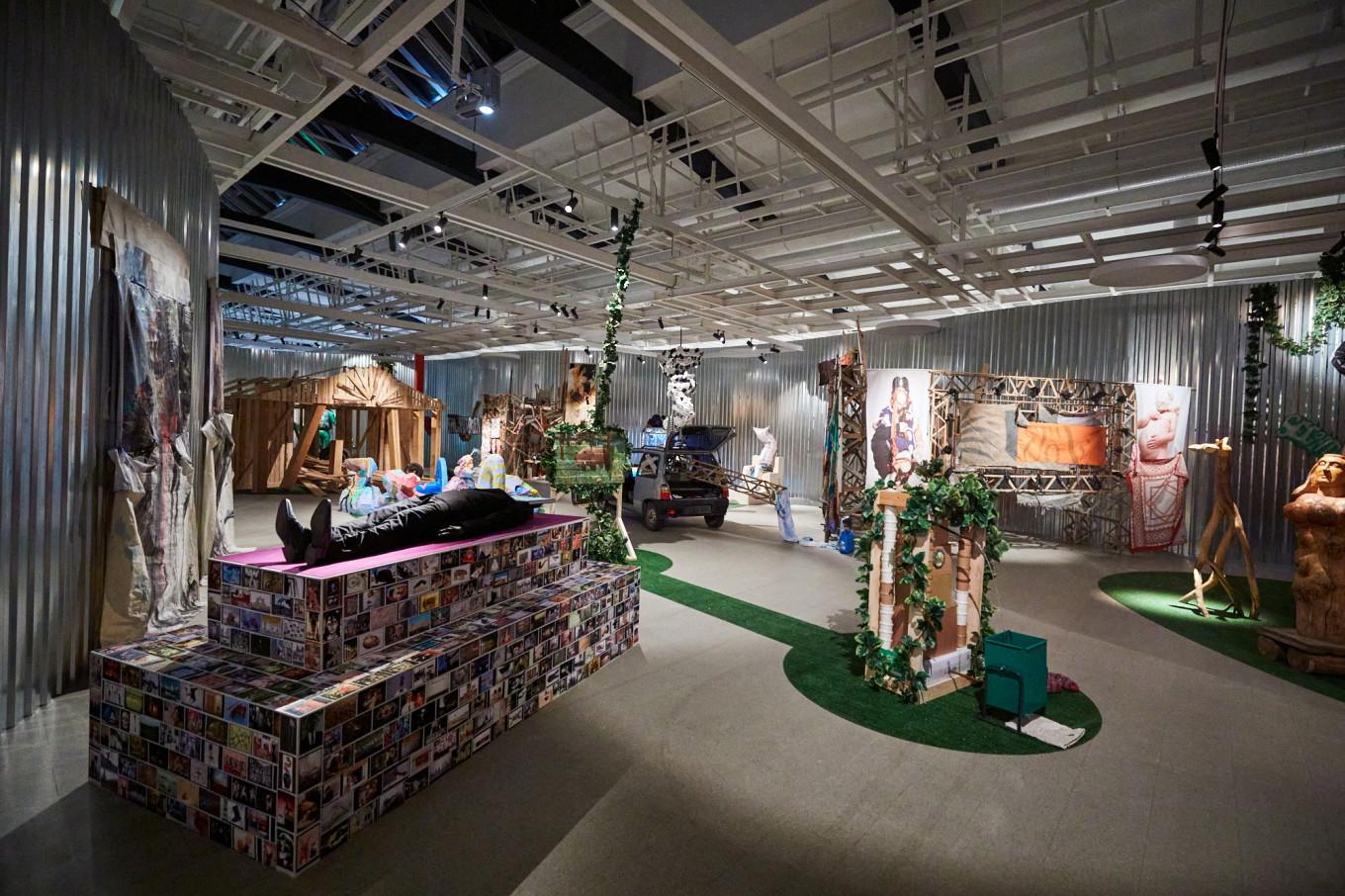“Once again, nothing is happening.”
This merciless slogan greets visitors from puffy white clouds as they enter the Manege Central Exhibition Hall in St. Petersburg. The installation by Mayana Nasybullova is just the first provocation from the curators of the exhibition called “Nemoskva [Not Moscow] Is Just Around the Corner.”
An imaginary elevator that never goes anywhere, a portrait of Nikolai Gogol made with strips of mattress, and a running machine as a symbol of human mortality are just some of the images and concepts from this thought-provoking display that is a joint initiative of the St. Petersburg’s Manege Central Exhibition Hall and Moscow’s Pushkin Museum of Fine Arts.
The project, which features 80 artists from 21 Russian cities and towns, brings cutting-edge contemporary Russian art from beyond Moscow closer to larger audiences and showcases the creative potential and great variety of Russia beyond the Ring Road. The exhibition was conceived and put together by a team of seven curators: Svetlana Usoltseva, Oksana Budulak, Vladimir Seleznev, Artem Filatov, German Preobrazhensky, Evgeny Kutergin and Antonio Geusa.

The St. Petersburg exhibition is the third event in an extensive series called Nemoskva [literally “not Moscow,” although the project in English is called “More Than Moscow”] that started in 2018, when a group of international experts participated in a travelling symposium held in 13 cities along the Trans-Siberian Railway. Out of that symposium came the idea for a series of exhibitions. The first NeMoskva exhibition was held at the BOZAR Center for Fine Arts in Brussels, followed by the launch of a nomadic school for curators, the first of which was held in the town of Satka in Chelyabinsk oblast.
The title of the exhibition is a reference to an installation by Russian artist Boris Matrosov in Perm, which declared that “Happiness is just around the corner.”

The project’s participants are definitely not afraid of strong statements. “You Will Die Anyway” reads a blinking red neon line over a lone running machine. Perm artist Alexei Ilkayev chose the running machine as a symbol for the new fashion for healthy lifestyles. The result is people denying their age and the “hamster wheel” syndrome, when meaning and purpose fall victim to routine.
Krasnoyarsk artist Syomych S. B. is currently serving in the army. His installation, the “School of Humility,” is the reconstruction of a spartan barrack, where screens above the conscripts’ beds showcase the author’s drawings or quotes from his letters, making for one of the project’s most emotional, private and deeply personal artworks.
Perm-born artist Asya Marakulina, who is now living in St. Petersburg, made an installation called “The Seam Rule” that is a kind of survival guide in a new city that at times feels alien and alienating.
“I didn’t mean for ‘the Seam Rule’ to become a project. It was conceived as a sort of recollection of my personal secret behavioral practice in a new city,” Marakulina told The Moscow Times. “I made up rules to weave my body into the canvas of the city, where I felt like an outsider. Those rituals of sewing, cutting and playing thread-and-needle served as a support tool for me during the adaptation period.” Marakulina took a special interest in urban traffic patterns, and she spent time monitoring people’s movements in public places, trying to see a structure behind what originally seemed to be chaos.

The Park for Recreation and Leisure immersive installation on the second floor is the project’s hidden gem.
This amusement park hidden behind the high black walls echoes the style and atmosphere of its many incarnations across Russia. The section’s curator Vladimir Seleznev sought to recreate not just the structure of a typical Russian park, complete with roundabouts, city sculptures, little shops, game stations and gigs, but its particular feel and aesthetics — even the somewhat eerie feeling that its rusted rides evoke. “When you enter the park, you face reality in its naked truth, and life, whatever it is for you at this very moment is staring you straight in the face,” Seleznev told The Moscow Times.
“At the same time, this park is also the territory of dreams. In this sense, it is a mystery park, a depository of lost hopes and sad memories, a place where wooden sculptures are almost the only residents and video surveillance cameras record emptiness,” he said.

Throughout the exhibition, fairytale imagery fuses with the symbolic features of Russian reality. “Ionization,” an installation by the Yekaterinburg art group GUI, is a tongue-in-cheek reference to the story of Jonah and the whale. Yet a few steps away you find an imaginary elevator that doesn’t go anywhere, created by the St. Petersburg artist Dmitry Zheravov. Even though you can’t enter, you linger for a while by this small art object — not only a reference to the many broken elevators across Russia, but also to the country’s failed system of “social lifts.”
In this both exciting and sobering display, contemporary art emerges as a tool for retaining mental sanity and building emotional resilience. Charged with willpower, sarcasm, empathy and vigor, the exhibition offers a captivating, turbulent and vibrant journey through Russian art and Russian life today.
The show will run through October 15.
For more information about this and other shows, see the Manege site here.






